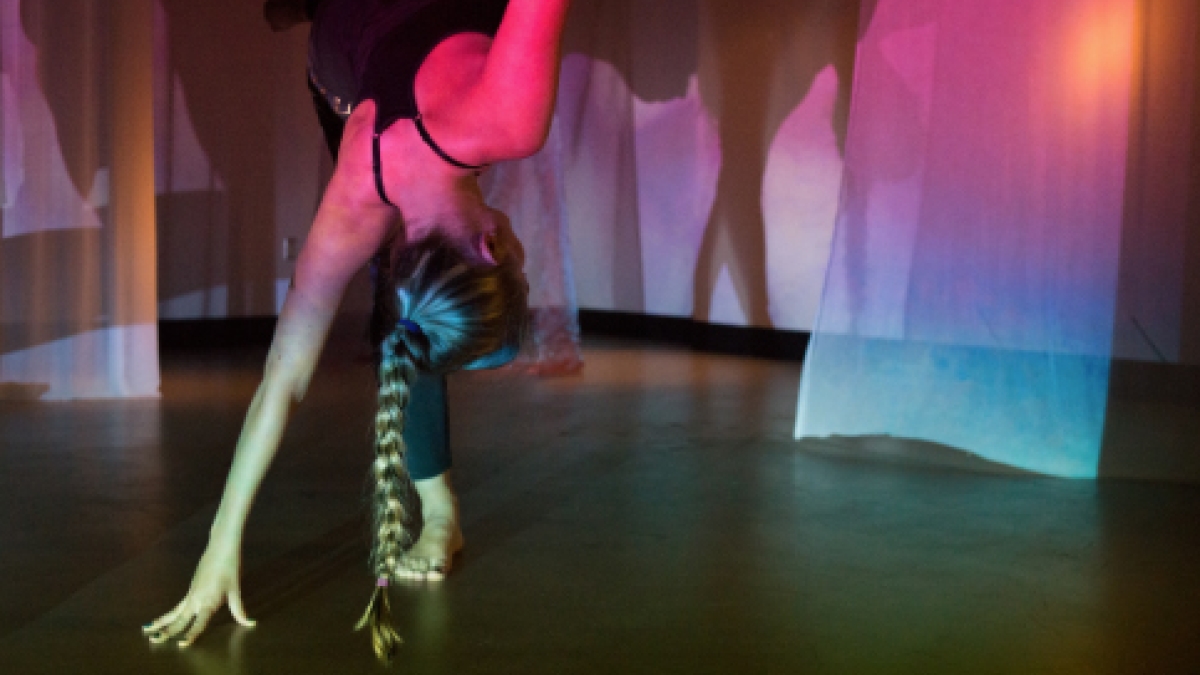Dance and Media Arts and Sciences Graduate Students Explore the Struggle Between Perception and Reality in Vertigo

Photo courtesy of Herberger Institute for Design and the Arts
“Vertigo,” an original choreographic and sound score by two Herberger Institute for Design and the Arts graduate students at Arizona State University, shuffles the content of consciousness, eliminates our linear perception of time and transforms the space into a responsive environment. The use of interactive media and sensing systems allows the performing bodies (dancers) to transport the surrounding environment into their perception of the experience.
The artists – Michael Krzyzaniak (composer and Media Arts and Sciences PhD student in the School of Arts, Media and Engineering) and Julie Akerly (choreographer and Interdisciplinary Digital Media and Performance MFA student in Dance) – define the performance this way: “In a state of vertigo, the internal perception of movement differs from the external perception of the experience. The dancers in ‘Vertigo’ attempt to separate the mind and body by ignoring stimuli perceived through their senses or by attempting to eliminate habitual patterns, inhibition, and the sensation of passing time from their awareness. Throughout the piece the performers will wrestle with a struggle between perception and reality.”
The choreographer Julie Akerly says, “My graduate advisor is Becky Dyer, a faculty member in ASU’s School of Film, Dance and Theatre, and ‘Vertigo’ – the performance – is created out of ‘workshops’ that I did with a pilot study group.” The original project was a blind study with somatically aware dancers using the systems that were designed for those workshops.
When Akerly first came to ASU and entered into an interdisciplinary media design and performance degree, she thought she would be making films and static projections that played behind dancers. Never did she think that she would be learning to design interactive and responsive systems that have the potential to create a real sense of interaction where not only is the dancer responding to the media, but also the media is responding to the dancer.
Akerly says, “Arts, Media and Engineering (AME) at Arizona State University has introduced me to other graduate students with similar interests and provided me with the theoretical and technological resources I need to experiment with designing interactive performances.”
Akerly and Krzyzaniak met in the AME class “Understanding Activity,” where they worked in a team with other AME students to design a performance project. They – along with Arts, Media and Engineering PhD graduate student Muharrem Yildirim – continued to work on that project beyond the class and developed "Separation: Short Range Repulsion," which premiered at Slingshot Festival in Athens, Ga., in March 2013.
Krzyzaniak – the composer – says of writing for dance performances, “At its heart, composing for dance is very similar to composing other forms of music. However, dance additionally offers the possibility of translating the aesthetic experience of improvised movement in real time. Sensors can be used to evaluate the aesthetic content of the dance as it unfolds, and that information can be used to control the aesthetic content of real-time music. In this model, the composer becomes a meta-composer. Rather than composing music that has a particular aesthetic quality, the composer builds a system that is capable of maintaining aesthetic synchrony with the dancer.”
You can see Akerly’s and Krzyzaniak’s “Vertigo” at its opening reception on Wednesday, October 2, 2013 from 7 – 8 p.m.
asuevents.asu.edu/digital-culture-gallery-presents-vertigo-julie-akerly-and-michael-krzyzaniak
Oct. 2, 2013, 7- 8 p.m.
Digital Culture Gallery
free
Public Contact:
Felicity Snyder
Program Manager
480.965.9438
Media Contact:
Felicity Snyder
480.965.9438